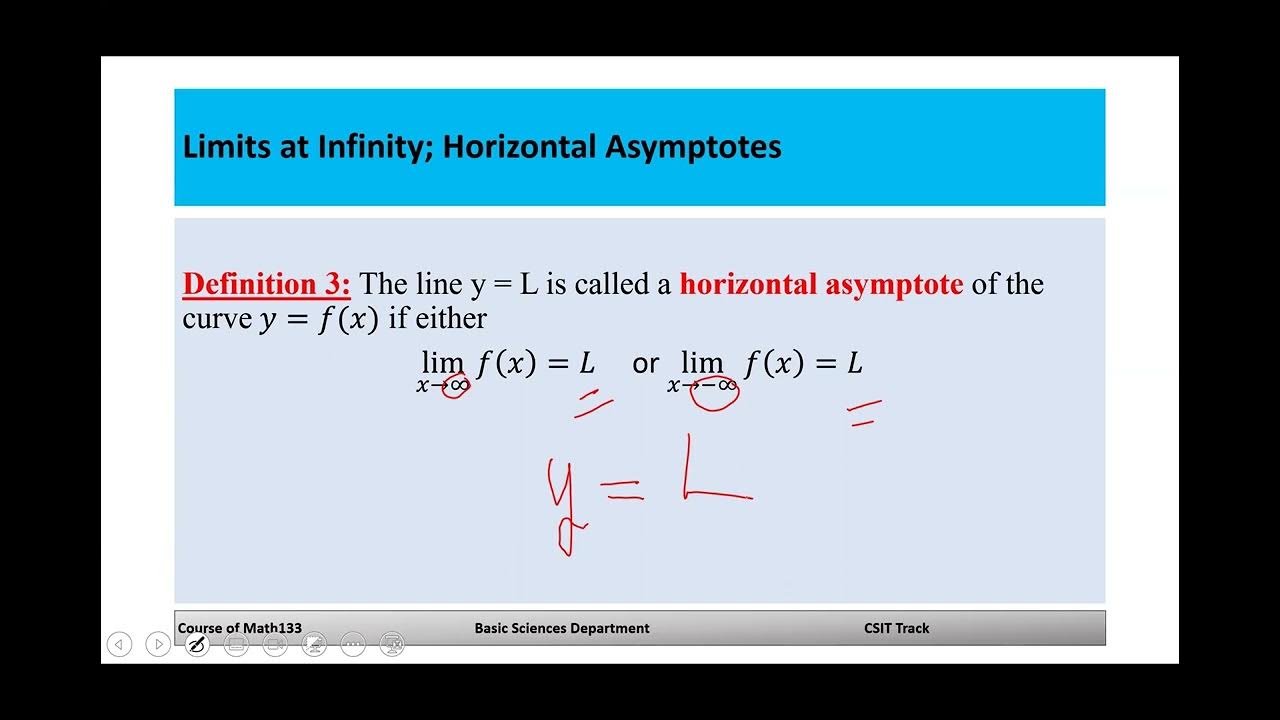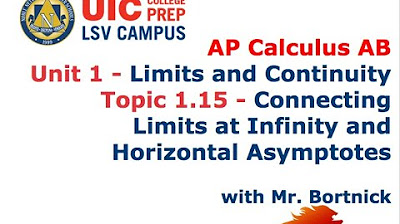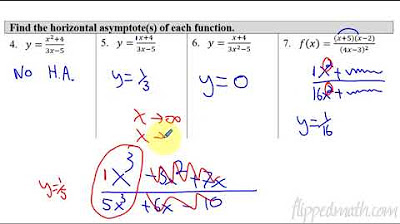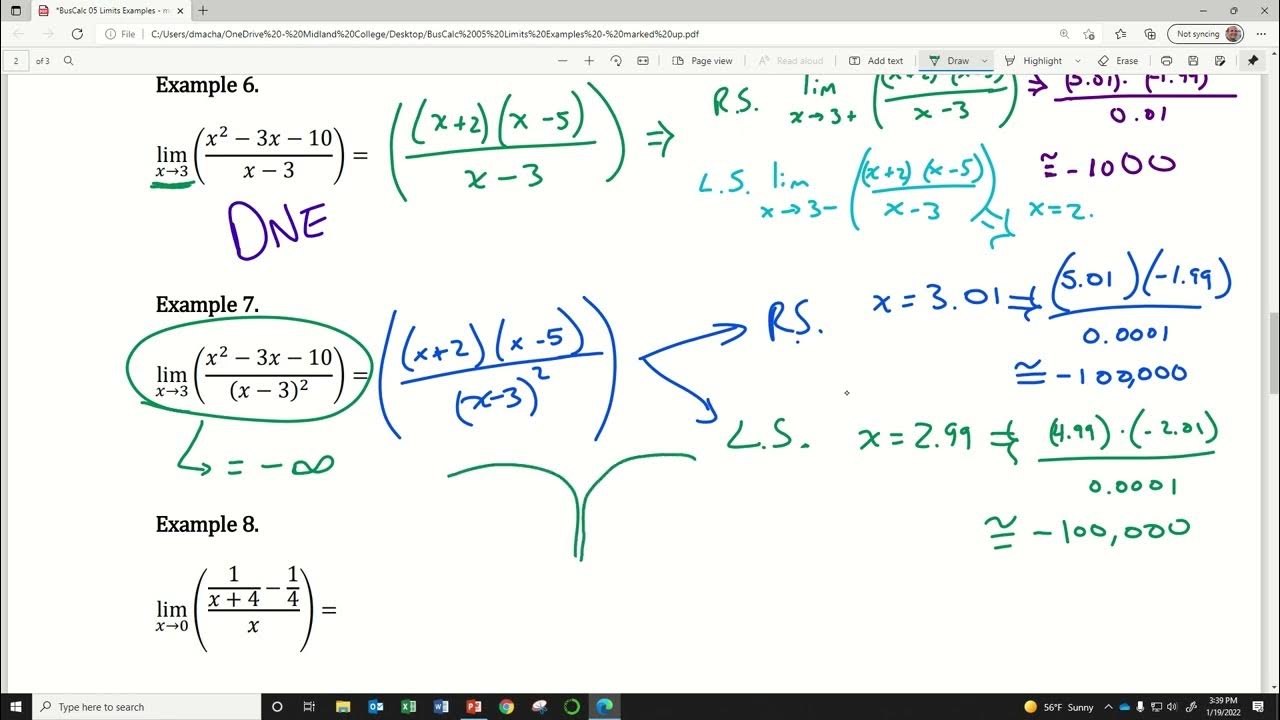Calculus 1 Lecture 3.5: Limits of Functions at Infinity
TLDRIn this informative transcript, the focus is on understanding limits, particularly as X approaches infinity or negative infinity. The discussion delves into various cases, such as removable discontinuities, vertical and horizontal asymptotes, and the behavior of polynomial functions near infinity. The concept of limits is explored through examples and explanations, highlighting the importance of sign analysis and the application of limit rules. The transcript also emphasizes the significance of the leading term in a polynomial when evaluating limits at infinity and the need to rationalize expressions involving square roots. Overall, the content aims to deepen the understanding of limits and their applications in mathematical analysis.
Takeaways
- 📌 Understanding limits at infinity involves recalling key concepts such as functions approaching positive or negative infinity and the associated asymptotic behavior.
- 🔍 To identify discontinuities in rational functions, set the denominator equal to zero and solve for the variable, which will reveal holes or asymptotes.
- 🌐 At vertical asymptotes, the function cannot be canceled out or simplified, indicating a non-removable discontinuity.
- 📈 For horizontal asymptotes, the function approaches a constant value as x approaches infinity, indicating the limit exists and is finite.
- 🔄 When both sides of an equation approach the same infinity, the limit exists and is equal to that infinity (positive or negative).
- 🚫 If one side approaches positive infinity and the other negative infinity, the limit does not exist.
- 📚 The sign analysis test is used to determine the behavior of functions around vertical asymptotes and to find the intervals where the limit may exist or not exist.
- 🌟 Polynomials always approach positive or negative infinity depending on the leading term's power, regardless of the direction of infinity approached.
- 🛑 Infinity minus or plus infinity, or infinity over infinity scenarios are undefined and require manipulation or rationalization to resolve.
- 💡 When dealing with limits at infinity, it's crucial to consider the behavior of the leading term of a polynomial, as it dictates the function's ultimate behavior.
Q & A
What is the main topic discussed in the transcript?
-The main topic discussed in the transcript is the concept of limits in calculus, specifically focusing on limits at infinity and how to determine different types of asymptotes and discontinuities in functions.
What is an ASM toote?
-An ASM toote (asymptote) is a line that a function approaches but never actually reaches. It can be either vertical or horizontal. A vertical asymptote occurs when the function approaches infinity or negative infinity at a certain point, while a horizontal asymptote occurs when the function approaches a constant value as x approaches infinity or negative infinity.
What is a removable discontinuity?
-A removable discontinuity is a type of discontinuity in a function where the point of discontinuity can be 'removed' by performing algebraic manipulations on the function. This typically occurs when both the numerator and denominator of a rational function are zero at the same point, allowing for simplification and the removal of the discontinuity.
How do you determine if a discontinuity is removable or not?
-To determine if a discontinuity is removable, you need to check if the function's numerator and denominator both become zero at the same value of x. If they do, and the function can be simplified to remove the factor causing the discontinuity, then it is removable. If not, the discontinuity is non-removable and results in a vertical asymptote.
What is the significance of the sign analysis test in determining limits?
-The sign analysis test is used to determine the behavior of a function near vertical asymptotes. By evaluating the function's sign on either side of the discontinuity, you can determine whether the limit exists and what the limit is as x approaches the point of discontinuity from the left and from the right.
How does the behavior of a polynomial function change as x approaches infinity?
-As x approaches infinity, a polynomial function will also approach infinity, either positive or negative, depending on the sign of the leading term's coefficient. The function's behavior will follow the power of the leading term, with higher powers dominating the function's growth or decay at infinity.
What is the limit of a constant over any power of x as x approaches infinity?
-The limit of a constant over any power of x as x approaches infinity is zero. This is because the constant remains unchanged while the denominator grows without bound, leading to a limit of zero.
What is the limit of a function with a square root in the denominator as x approaches infinity?
-The limit of a function with a square root in the denominator as x approaches infinity involves rationalizing the expression first. After rationalizing and simplifying, you would divide every term in the numerator and the denominator by the largest power of x in the denominator. The result will be a limit that either approaches zero (for a horizontal asymptote) or positive/negative infinity, depending on the behavior of the polynomial part of the function.
How does the concept of infinity affect the evaluation of limits?
-Infinity is a concept that helps in understanding the behavior of functions without having to plug in an actual infinite value. It allows us to describe the behavior of a function as it grows or decreases without bound. When evaluating limits at infinity, we consider the leading terms of polynomials and the behavior of rational functions near vertical asymptotes to determine if the limit exists and what it is.
What is the horizontal asymptote of a function as x approaches positive or negative infinity?
-The horizontal asymptote of a function as x approaches positive or negative infinity is the value that the function approaches as x becomes very large in either the positive or negative direction. It can be zero, a non-zero constant, or it may not exist at all, depending on the behavior of the function.
Outlines
📚 Introduction to Limits at Infinity
The paragraph discusses the concept of limits at infinity, specifically when the function approaches positive or negative infinity. It introduces the idea of asymptotes and removable discontinuities, explaining how to determine their presence using sign analysis tests. The importance of understanding where the function goes to infinity and how to handle cases of holes and asymptotes is emphasized, setting the stage for a deeper exploration of these concepts.
🔍 Identifying Discontinuities and Asymptotes
This section delves into methods for identifying discontinuities in rational functions, particularly focusing on how to find them using the denominator of the function. It explains the difference between removable discontinuities (holes) and non-removable ones (asymptotes), and provides a clear example to illustrate the concepts. The paragraph reinforces the importance of sign analysis in determining the nature of these discontinuities and preparing for their occurrence.
📈 Understanding Asymptotic Behavior
The paragraph explores the behavior of functions as they approach infinity, discussing the implications of vertical and horizontal asymptotes. It explains how the sign of the function changes around the points of discontinuity and how to use sign analysis to determine the limit. The concept of polynomial limits at infinity is introduced, stating that the limit will approach positive or negative infinity depending on the direction of the approach, with the behavior following the highest power term of the polynomial.
🌐 Examples of Limits at Infinity
This part of the script provides examples to illustrate the concepts of limits at infinity. It shows how to compute the limit of a function as x approaches positive or negative infinity, using the rules of limits and the behavior of polynomials. The examples highlight the importance of simplifying expressions and understanding the role of leading terms in determining the limit's behavior at infinity.
🤔 Handling Infinity in Limits
The paragraph discusses the challenges and considerations when dealing with limits involving infinity, such as infinity minus infinity or infinity over infinity. It emphasizes the importance of rationalizing expressions and avoiding undefined operations. The concept of horizontal asymptotes at zero is introduced, explaining how to identify and work with such limits, and how they differ depending on the direction of infinity (positive or negative).
🧠 Advanced Limit Concepts and Rationalization
This section tackles more complex scenarios involving limits at infinity, focusing on rationalization and the manipulation of expressions to simplify limits. It explains how to handle cases where you have a square root of infinity and how to rationalize expressions to make them manageable. The paragraph also touches on the importance of considering the type of problem and the behavior of polynomials when dealing with limits at infinity.
Mindmap
Keywords
💡Limits
💡Infinity
💡Asymptotes
💡Polynomials
💡Sign Analysis
💡Rational Functions
💡Discontinuities
💡Leading Term
💡Simplification
💡Roots
Highlights
Discussion on limits at infinity, focusing on functions approaching positive or negative infinity.
Explanation of how to handle discontinuities in functions, specifically removable and non-removable cases.
Use of sign analysis test to determine the behavior of limits with respect to discontinuities.
Illustration of the concept of vertical asymptotes and their role in the behavior of function limits.
Discussion on the behavior of rational functions with respect to their denominators and discontinuities.
Explanation of how to identify and handle holes in functions using algebraic techniques.
Introduction to the concept of horizontal asymptotes and their significance in the study of limits.
Analysis of polynomial functions and their behavior as x approaches positive or negative infinity.
Demonstration of how to compute limits involving polynomial functions using leading term analysis.
Explanation of the behavior of functions with square roots and absolute values as x approaches infinity.
Use of rationalization techniques to handle limits involving square roots and infinity.
Discussion on the importance of considering the direction of infinity (positive or negative) when computing limits.
Illustration of how to manipulate and simplify expressions to compute limits at infinity.
Explanation of the concept of indeterminate forms and how to resolve them in limit calculations.
Demonstration of the impact of changing a single term in a function on the behavior of its limits.
Overview of the rules for limits as x approaches infinity, emphasizing their application in problem-solving.
Transcripts
Browse More Related Video

Math 133 Lecture 2 6

Limits of Inverse Trigonometric Functions | Calculus

Business Calculus - Math 1329 - Section 1.5 (and 1.6) - Limits and Continuity

AP Calculus AB - 1.15 Connecting Limits at Infinity and Horizontal Asymptotes

Calculus AB/BC – 1.15 Limits at Infinity and Horizontal Asymptotes

BusCalc 05 Limits Examples Pt 2
5.0 / 5 (0 votes)
Thanks for rating: